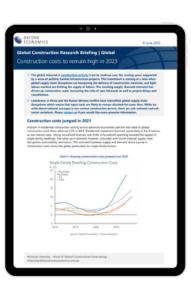Global construction costs to remain high in 2023

The global rebound in construction activity is set to continue over the coming years, supported by a wave of publicly funded infrastructure projects. This investment is coming at a time when global supply chain disruptions are hampering the delivery of construction materials, and tight labour markets are limiting the supply of labour. The resulting supply-demand mismatch has driven up construction costs, increasing the risks of cost-blowouts as well as project delays and cancellations.
Lockdowns in China and the Russia-Ukraine conflict have intensified global supply chain disruptions which means that input costs are likely to remain elevated for some time. While we write about national averages in our various construction service, there are sub-national and sub-sector variations. Please contact us if you would like more granular information.
What you will learn:
-
The global rebound in construction activity is set to continue over the coming years, supported by a wave of publicly funded infrastructure projects. This investment is coming at a time when global supply chain disruptions are hampering the delivery of construction materials, and tight labour markets are limiting the supply of labour. The resulting supply-demand mismatch has driven up construction costs, increasing the risks of cost-blowouts as well as project delays and cancellations.
- A boom in residential construction activity across advanced economies saw the real value of global construction work done rebound 2.3% in 2021. Residential investment boomed, particularly in the Americas, as low interest rates, strong household finances, and shifts in household spending boosted the appeal of single-family dwellings.
- Global supply chains have remained stretched since the middle of 2020 and, with strong consumer and industrial demand for goods, has driven a jump in global container shipping charter rates. The construction sector is much more exposed to transportation costs than other parts of the economy due to the relatively low value-to-weight ratio of construction materials.
Tags:
Related posts

Post
The Construction Productivity Challenge in Australia
Delve into the state of construction productivity in Australia. Understand the factors affecting growth and how innovation can transform the industry for the better.
Find Out More
Post
The Next Chapter for Rail: From Megaprojects to Maintenance and Skills
Blog Global construction costs to remain high in 2023 Preparing Australia’s Rail Workforce for a Future Beyond Construction The infrastructure investment boom has dramatically transformed Australia’s rail sector. Over the past decade, we’ve seen extraordinary progress-from expanding metro networks to constructing major freight and regional rail projects. As I shared during my keynote at the...
Find Out More
Post
Global Construction Outlook Q2 2025
Reduced US tariffs are expected to support private sector activity, and we have increased our assumed proportion of total government investment being directed towards civil engineering construction work.
Find Out More